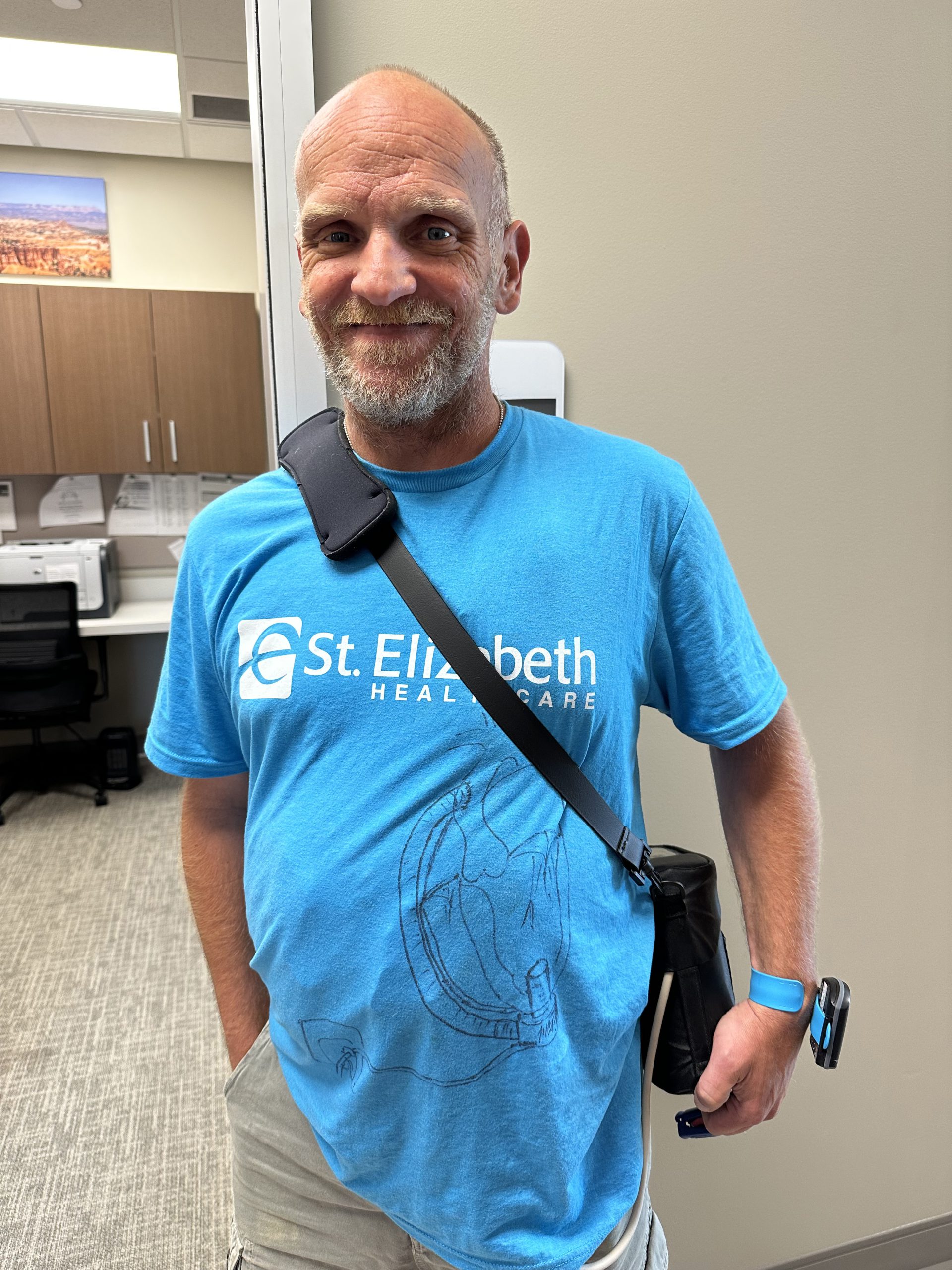Eric Callaway
LVAD Patient Celebrates Life-Giving Device
Eric Callaway celebrated his 40th birthday at St. Elizabeth Edgewood, where he was recovering from surgery to insert his new left ventricular assist device (LVAD). He felt lucky to be there.
Callaway was only 26 years old when he had his first heart attack – on his birthday. He credits St. Elizabeth with seeing that he continues celebrating birthdays, going to church, fishing with his nephews and walking about his Moores Hill, IN, neighborhood.
“Since I had my LVAD, I have a better life again,” he said. “I haven’t felt this good in a long, long time. I have more energy now than I did when I was 29, 30 years old. This LVAD has been a miracle for me.”
15 Years of Treatment for Heart Disease
Callaway’s medical journey began on that birthday years ago when he felt ill and visited an urgent care center. Their diagnosis was food poisoning. In the middle of the night, he awakened his mother and said, “Mom, I feel like I could just lay here and die.”
She took him to the emergency room at St. Elizabeth Dearborn Hospital. Ashok Penmetsa, MD, walked into his room the following day and asked Callaway, “Do you know why I’m here?”
Callaway recognized Penmetsa as the cardiologist who had treated two of his grandparents. “I’m too young for heart attacks,” Callaway recalled thinking, but the doctor confirmed that he had had one.

For more information or to make an appointment at the St. Elizabeth Advanced Heart Failure Management Center, go to stelizabeth.com/heartfailure or call (859) 301-0124.
Diagnosed with atherosclerotic heart disease with multi-vessel disease, Callaway had stents to open his blocked coronary arteries and was treated with medications for cardiac disease. He has a family history of heart disease, including an uncle who died of it at 38. Callaway’s condition was complicated by having uncontrolled diabetes and being a tobacco user.
In December 2021, he was admitted to St. Elizabeth with advanced heart failure, possibly triggered by pneumonia. His kidney function was also starting to fail. Subsequently, the St. Elizabeth Advanced Heart Failure Management Center and LVAD Program were consulted. His treatment continued with the placement of an automated implantable cardioverter defibrillator (AICD) to protect against sudden death from arrhythmias. He was also hospitalized to start intravenous medications so he could be discharged home with an improved quality of life while undergoing the LVAD evaluation.
Still, his condition worsened. “It became hard for me to do even simple chores and activities, like walking upstairs or carrying groceries into my home,” Callaway said. “I felt crummy all the time, and the LVAD has been a game-changer for me.”
At first, he was reluctant to have an LVAD because it would mean he couldn’t swim, one of his favorite activities. The prospect of a better quality of life won him over. In June 2022, just shy of his 40th birthday, he underwent surgery.
“I wouldn’t be here today if it weren’t for my LVAD, that’s for sure,” Callaway said. “My quality of life after the implant got so much better.”
LVAD Provides Life-Extending Treatment
An LVAD helps pump blood from the lower left heart chamber, called the left ventricle, to the rest of the body. It is implanted in a patient’s chest and connected through a small opening in the skin to a controller unit and battery pack worn outside the body.
“An LVAD can reduce the symptoms of severe heart failure, improve a patient’s quality of life and keep a patient alive longer, often while they wait for a heart transplant,” said Callaway’s surgeon, Mario Castillo-Sang, MD.
A multidisciplinary team of cardiologists, surgeons, nurse coordinators, social workers, nutritionists, pharmacists and palliative care specialists work with each patient in the LVAD program to provide comprehensive, individualized care.
“It can be challenging to adapt to life with an LVAD, but there are many rewards,” Dr. Penmetsa said. “Aside from swimming and contact sports, patients can exercise, travel and resume activities they enjoy.”
In addition to monthly check-ups at the Florence Wormald Heart & Vascular Institute at St. Elizabeth, Callaway participates in a quarterly LVAD support group. He said the group is close-knit because members understand each other’s physical and emotional challenges.
Casey Behne, RN, Callaway’s VAD Coordinator, said support group meetings include education, relaxation training and help connecting financial and health-support resources in their communities.
At a holiday party in late 2023, staff gave each support group member a T-shirt designed for LVAD patients. Lindsey Carroll, RN, BSN, the Nurse Manager of the Advanced Heart Failure Management Center, said the T-shirt is a more discreet way to carry equipment than the vest provided by the manufacturer.
Callaway credits his extensive medical team, including his primary care doctor, Christopher Walcott, MD, for their extraordinary support throughout his medical treatment and when he faced personal difficulties, such as the deaths of his parents.
Carroll, his first VAD coordinator, and Behne check in frequently with him by phone between visits. They continue to work with him on how to better manage his diabetes and quit smoking to become eligible for a heart transplant.
“These doctors and nurses here have just been so wonderful to me,” Callaway said. “They’re always there for me when I need them.”

